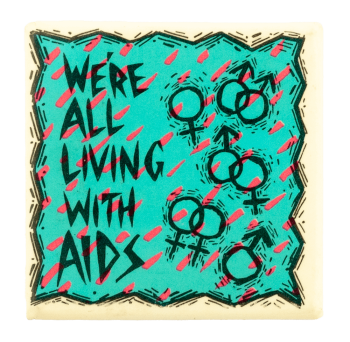| Category | |
|---|---|
| Additional Images | |
| Sub Categories | |
| Text on Button | WE'RE ALL LIVING WITH AIDS |
| Image Description | Teal and red sketch-style background with a black zig-zag outline, black text, and black illustrations of the symbols for "man" and "woman" in various combinations |
| Curl Text | © 1989 SOTOMAYOR, FOR RALPH |
| Back Style | |
| The Shape | |
| The Size | |
| Year / Decade Made | |
| Additional Information | Acquired Immunodeficiency Syndrome (AIDS) is a condition that develops from an infection of the Human Immunodeficiency Virus (HIV). AIDS typically creates a disintegration of the immune system that makes the person more susceptible to other infections. HIV/AIDS is primarily spread through unprotected sexual activity or needles contaminated with infected blood. It was first identified in humans in the United States in 1981, when previously healthy young gay men were contracting deadly diseases. In 1982, the Center for Disease Control (CDC) established four risk factors: male homosexuality, intravenous drug use, Haitian origin, and hemophilia A. As the epidemic spread, its association with gay men and drug use allowed for a damaging stigma that significantly furthered existing homophobia. The United States government was—and is, still—critiqued for ignoring the severity of the HIV/AIDS pandemic. President Ronald Regan first spoke the name of the disease when he identified it as a top priority in 1985 after continued outcry from activists. Between 1987 and 1998, over 300,000 people died of AIDS in the US. By 1995, one in fifteen gay men had died of AIDS. By the mid-1990s, HIV/AIDS numbers were steadily declining, with the introduction of effective treatment in 1986. There is still no cure for AIDS, however, preventative medication and viral suppression medicine has made great strides Infected individuals can reduce the amount of HIV in their blood to an undetectable level, allowing for long lives and dramatically reducing risks for their sexual partners. The sentence "We're All Living With Aids" and the symbols of a variety of genders and gendered pairings work to dismantle the incorrect label of "gay plague" that was rampant in the 1980s and continues to affect the cultural consciousness today. |
| Sources |
q40 years of HIV discovery: The first cases of a mysterious disease in the early 1980s. (2023, May 11). Institut Pasteur. https://www.pasteur.fr/en/research-journal/news/40-years-hiv-discovery-first-cases-mysterious-disease-early-1980s First winter climb of Mount Rainier, Washington, 1922 (clip). (n.d.). Retrieved July 31, 2024, from https://digitalcollections.lib.washington.edu/digital/collection/filmarch/id/499/ Gale (Ed.). (2017). Aids and HIV infection. In Human Diseases and Conditions (3rd ed.). Gale. https://search.credoreference.com/articles/Qm9va0FydGljbGU6NDc3MTkwNA==?aid=113901 HIV/AIDS Timeline. (n.d.). New York City AIDS Memorial. Retrieved August 10, 2024, from https://www.nycaidsmemorial.org/timeline Inc, G. (2019, June 28). Gallup Vault: Fear and Anxiety During the 1980s AIDS Crisis. Gallup.Com. https://news.gallup.com/vault/259643/gallup-vault-fear-anxiety-during-1980s-aids-crisis.aspx The AIDS epidemic’s lasting impact on gay men. (n.d.). The British Academy. Retrieved August 10, 2024, from https://www.thebritishacademy.ac.uk/blog/aids-epidemic-lasting-impact-gay-men/ |
| Catalog ID | CA0951 |


